MARIANI’SVirtual Gourmet
September 18, 2011
NEWSLETTER
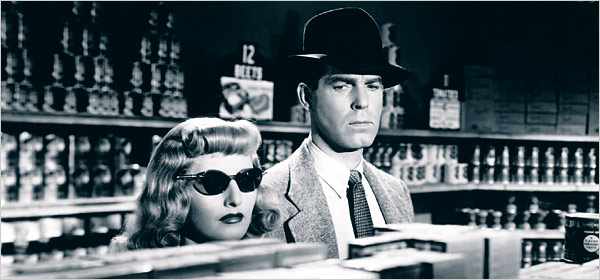
Follow @VirtualGourmet
Very Important Announcement!
 |
My latest book, written with Jim Heimann and Steven Heller, Menu Design in America, 1850-1985 (Taschen Books), has just appeared, with nearly 1,000 beautiful, historic, hilarious, sometimes shocking menus dating back to before the Civil War and going through the Gilded Age, the Jazz Age, the Depression, the nightclub era of the 1930s and 1940s, the Space Age era, and the age when menus were a form of advertising in innovative explosions of color and modern design. The book is a chronicle of changing tastes and mores and says as much about America as about its food and drink.
“Luxuriating vicariously in the pleasures of this book. . . you can’t help but become hungry. . .for the food of course, but also for something more: the bygone days of our country’s splendidly rich and complex past. Epicureans of both good food and artful design will do well to make it their cofee table’s main course.”—Chip Kidd, Wall Street Journal.
“[The menus] reflect the amazing craftsmanship that many restaurants applied to their bills of fare, and suggest that today’s restaurateurs could learn a lot from their predecessors.”—Rebecca Marx, The Village Voice.
“Restaurateurs, take note: A resurgence in thoughtful, artistic menus is past due.”—Bon Appetit Magazine |
THIS WEEK
ROME'S BEST: FROM ABBACCHIO TO ZABAGLIONE
by John Mariani
NEW YORK CORNER: LA SILHOUETTE
by John Mariani
MAN ABOUT TOWN: KOMALI
by Christopher Mariani
WINE: MERLOT SHINES UNDER NORTHSTAR
by Brian A. Freedman
featuring restaurant articles by John Mariani and others from around the USA.
THIS WEEK: What's the Real Value of the
Zagat Guide?
“A” IS FOR ABBACCHIO AND
“Z’ IS FOR ZABAGLIONE
By John Mariani
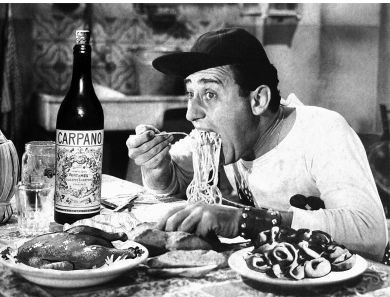
Of course, Italians like nothing more than to dismiss the gastronomy of Rome as too excessive, too rich, and too expensive. Of course, Italians in every city say similar things about every other city too, but when it comes to Rome, I think the rest of Italy is just plain jealous. In fact, Rome has a much deeper, broader gastronomy than any other Italian city. Indeed, the old adage that all roads lead to Rome might describe the infusion of meats, seafood, and vegetables that pour into the city night and day. Rome has a wide-ranging indigenous cuisine that includes beloved dishes like abbacchio (baby lamb with mint) coda alla vaccinara (braised oxtail), carciofi alla giudea (fried baby artichokes) trippa alla romana (stewed tripe), spaghetti alla carbonara (with eggs and bacon) and cacio e pepe (pasta with pecorino cheese and black pepper), while happily welcoming other regional specialties to its belly, so that you can get first-rate Sicilian, Tuscan, and Abruzzese cooking in the city’s restaurants.
I will admit that the wines of Rome’s region of Latium are only beginning to distinguish themselves, despite 26 D.O.C. appellations—few of which you will ever run across in the city’s enotecas. That failing aside, Rome has the best of everything. Here’s where to find it.
Prices reflect an average three-course dinner for two, without wine, but including tax and service.
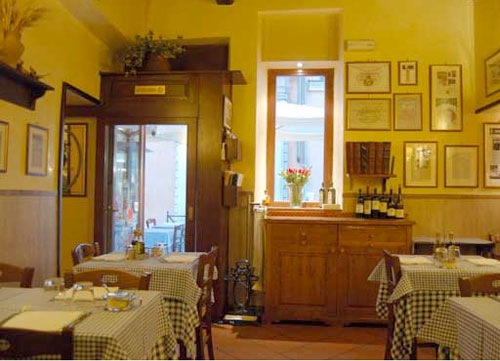
BEST OLD-FASHIONED ROMAN COOKING

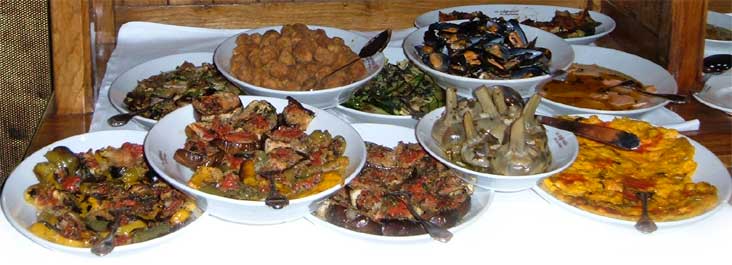 SPAGHETTI
ALLA CARBONARA
SPAGHETTI
ALLA CARBONARA
Calling itself La
Carbonara (Piazza Campo de Fiori, 23; 06-6864-783.
$120) suggests a certain
pride in this quintessential Roman dish in which
full-flavored eggs beaten with Parmigiano, black
pepper, and guanciale bacon are actually cooked by the
heat of the pasta. This is a very friendly and
comfortable trattoria on the lovely Campo dei Fiori
flower market, and it does indeed serve one of the
finest renderings of the namesake pasta in the
city. The incorporation of the ingredients at
the precise moment gives the dish a satiny sheen, with
a salty edge, a peppery spike, and a luxurious melding
of cheese and egg—not a bad idea for breakfast, if La
Carbonara was open then. They also do
light-as-a-feather potato gnocchi with a bright tomato
sauce. (There is another, unrelated restaurant of the
same name on the Via Panisperna.)
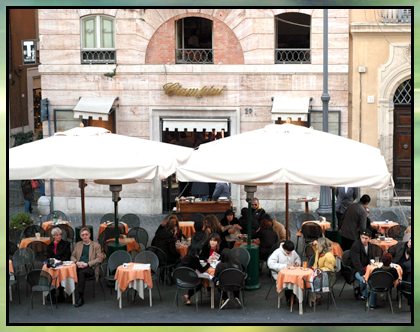
A few blocks from the teeming Spanish Steps, Ciampini is a chic corner café on the beautifully restored triangular Piazza San Lorenzo, with lots of marble and shining brass inside. Sit under its umbrella-shaded tables and watch the Romans sashay—and they do sashay by---without, as yet, too much of an intrusion of the touristi who haven’t yet discovered this charming spot. The natives walk arm in arm, they dress well, they sit down for a pastry and espresso, and let time go by as it always does.
BEST FETTUCCINE ALL’ALFREDO
Where else but at Alfredo’s on the Piazza Augusto Imperatore (06-687-8734; $120). Although not on the original premises, Alfredo’s is still run by the De Lelio family whose paterfamilias, Alfredo, created the luscious egg noodle-butter-and Parmigiano (no cream!) dish in 1914 to bring back his wife’s post-natal appetite. It will surely stir yours. The restaurant has a fine art deco cast, and the photos of movie stars and other celebrities who have dined here is astonishing, including Douglas Fairbanks and Mary Pickford who in 1927, while on their honeymoon in Rome, gave them inscribed golden fork and spoons—Alfredo’s uses copies to this day. Since it's become a ritual for celebrities, like Jimmy Stewart to the right, to have their photo taken eating fettuccine. (Another restaurant, on the original’s pre-war premises on the Via della Scrofa, of the same name is not related.)
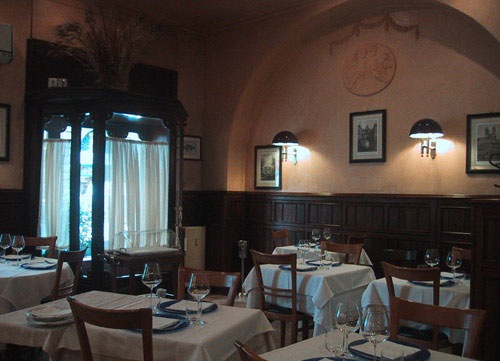 FAVORITE
RESTAURANT
FAVORITE
RESTAURANT
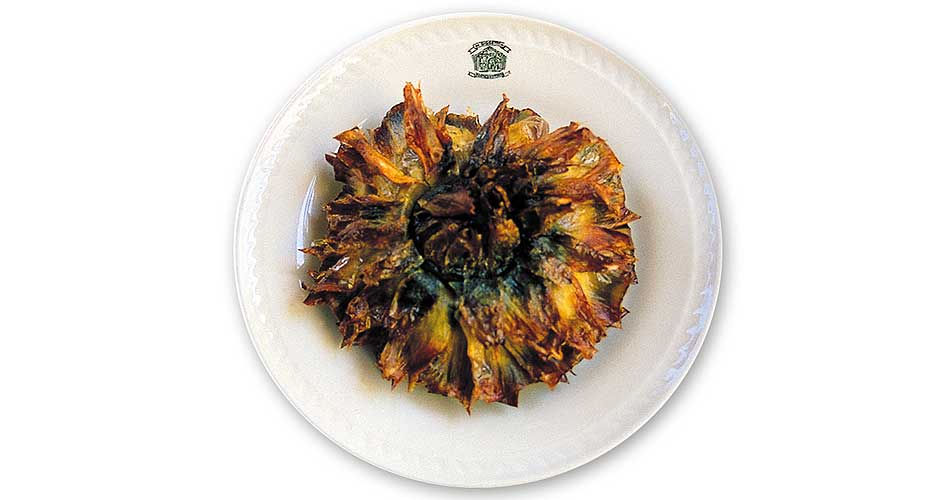
Baby artichokes fried crisp in olive oil (right) was a dish made famous in Rome’s former Jewish ghetto (enclosed in 1556 and dismantled as of 1870; visit the Jewish museum within the nearby Synogogue) near the Tiber, and the dish thus called carciofi alla giudea. One of the best versions—they crunch in the mouth with one bite--is at Da Giggetto (Via del Portico d'Ottavia, 21a; 06-686-1105; $110), which serves more than 500 a day. Their stuffed and fried zucchini blossoms, oozing ricotta, are also wonderful, and there’s a full menu of course.
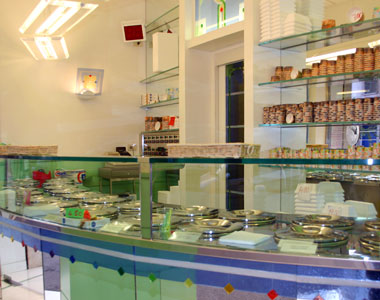
BEST
COFFEE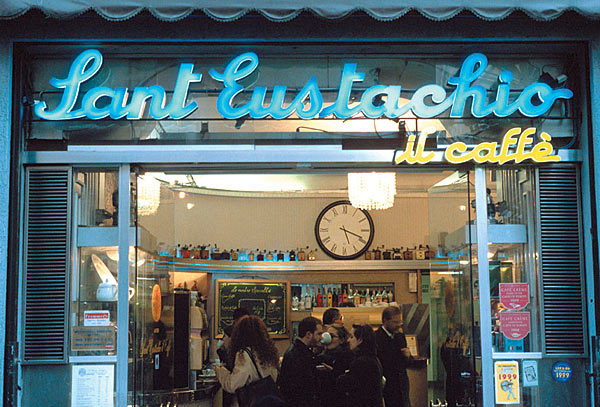
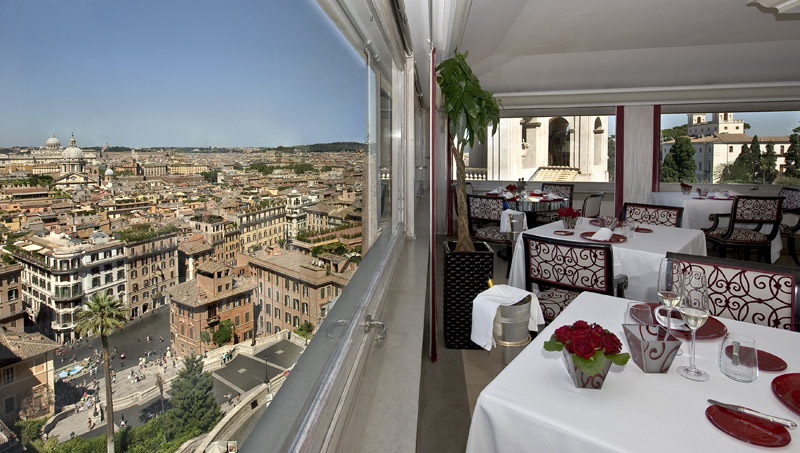 BEST PANORAMA
BEST PANORAMA
BEST
WINE BAR
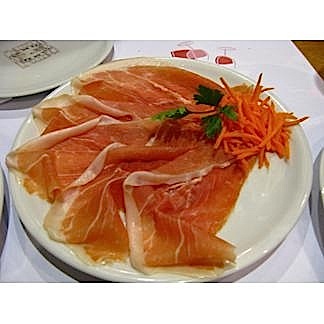
An old and revered favorite is the tiny Cul de Sac (73 Piazza
Pasquino ; 06-6880-1094. $70) a
stone’s throw from the Piazza Navona, a little
trattoria with outdoor tables outside and attached
wine store with more than 1,400 selections, along with
a wide selection of grappas, amaros, and digestivi,
and a menu with all the Roman favorites, including
lustrous charcuterie like Prosciutto (right),
culatello, and salsicce.
WHERE CAN I LEARN ABOUT ITALIAN WINE?
as also become home to the International
Wine Academy of Rome, (Vicolo
del Bottino, 8; 06-699-0878; $140) located
in a Sixteenth Century palazzetto, run by the
redoubtable Ian Domenico D’Agata, an American who gave
up a practice in pediatric gastroenterology to devote
himself to his passion for Italian wines;. Here
you may take a wide array of wine courses, from a
half-day course to an evening of eight weekly
sessions. Classes are followed by lunch or dinner at
the very fine Aroma
del Palazzetto restaurant attached to the
Academy.
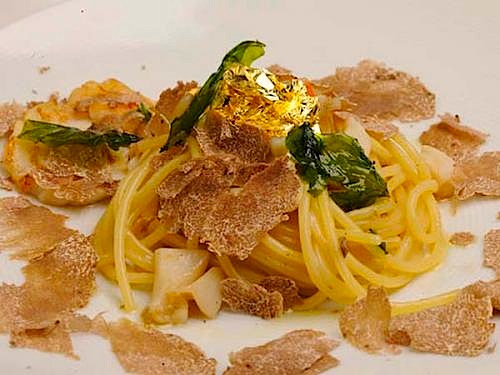 BEST SEAFOOD
BEST SEAFOOD
NEW
YORK CORNER
by John Mariani
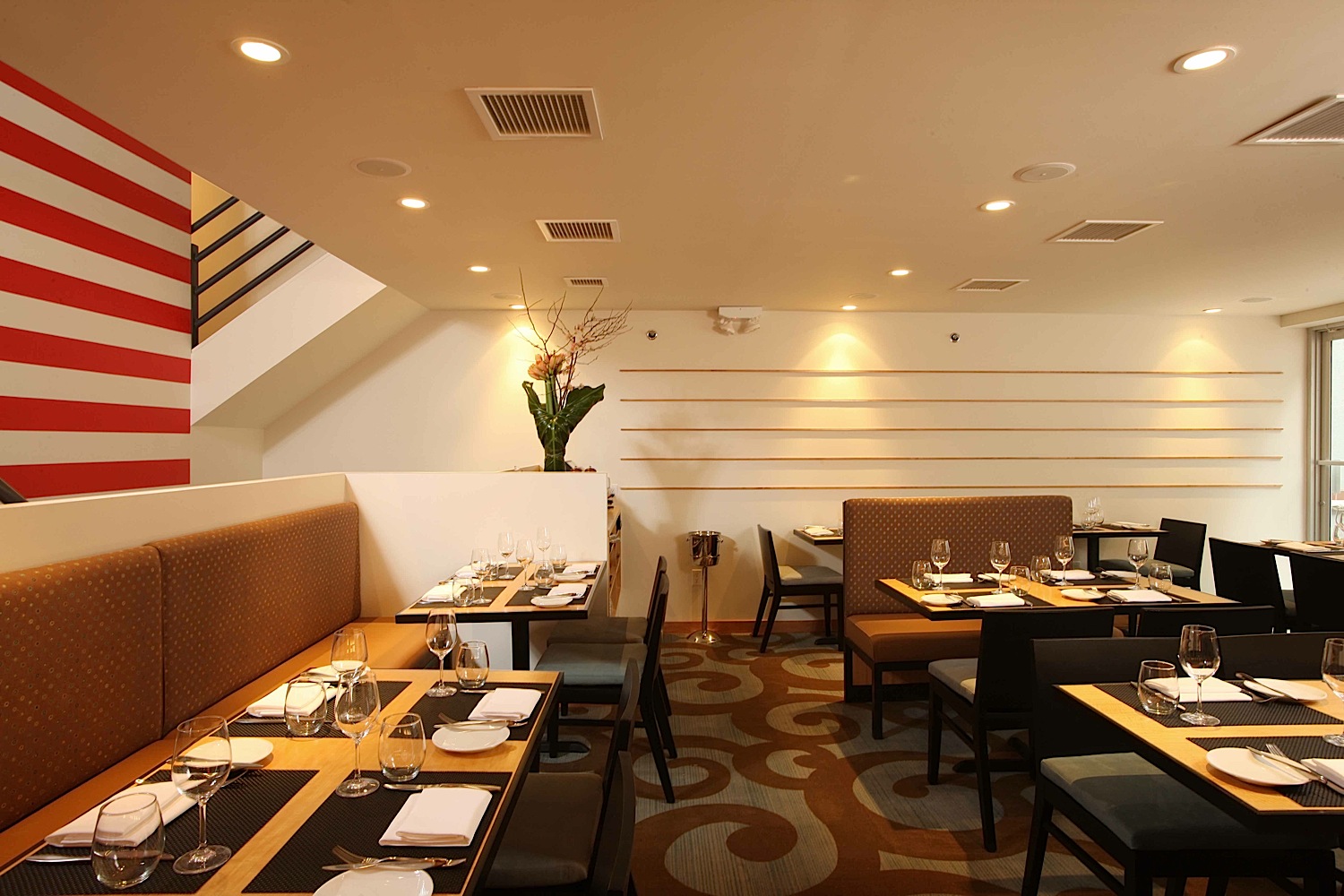
362 West 53rd Street
212-581-2400
la-silhouettenyc.com
Clearly owing to the sheer number of restaurants opening year-round in NYC, my missing some gems is inevitable. In a sense, missing the opening of La Silhouette, Sally Chironis and Tito Rahman's two-level French restaurant in Hell's Kitchen turned out for the best. For while I have no idea what the food tasted like when the restaurant opened in January, what I tasted from the kitchen of new chef Matthew Tropeano makes me regret nothing. I know Tropeano's work from his tenure as chef at La Grenouille, the staunchly classic French restaurant on the east side, where the menu rarely changed at all from year to year, and, while delivered with consistent finesse, gave Tropeano very little leeway or ability to express his own creativity. Now, at La Silhouette, he can and does, while maintaining an admirable link to all that is good and precise about French cuisine.
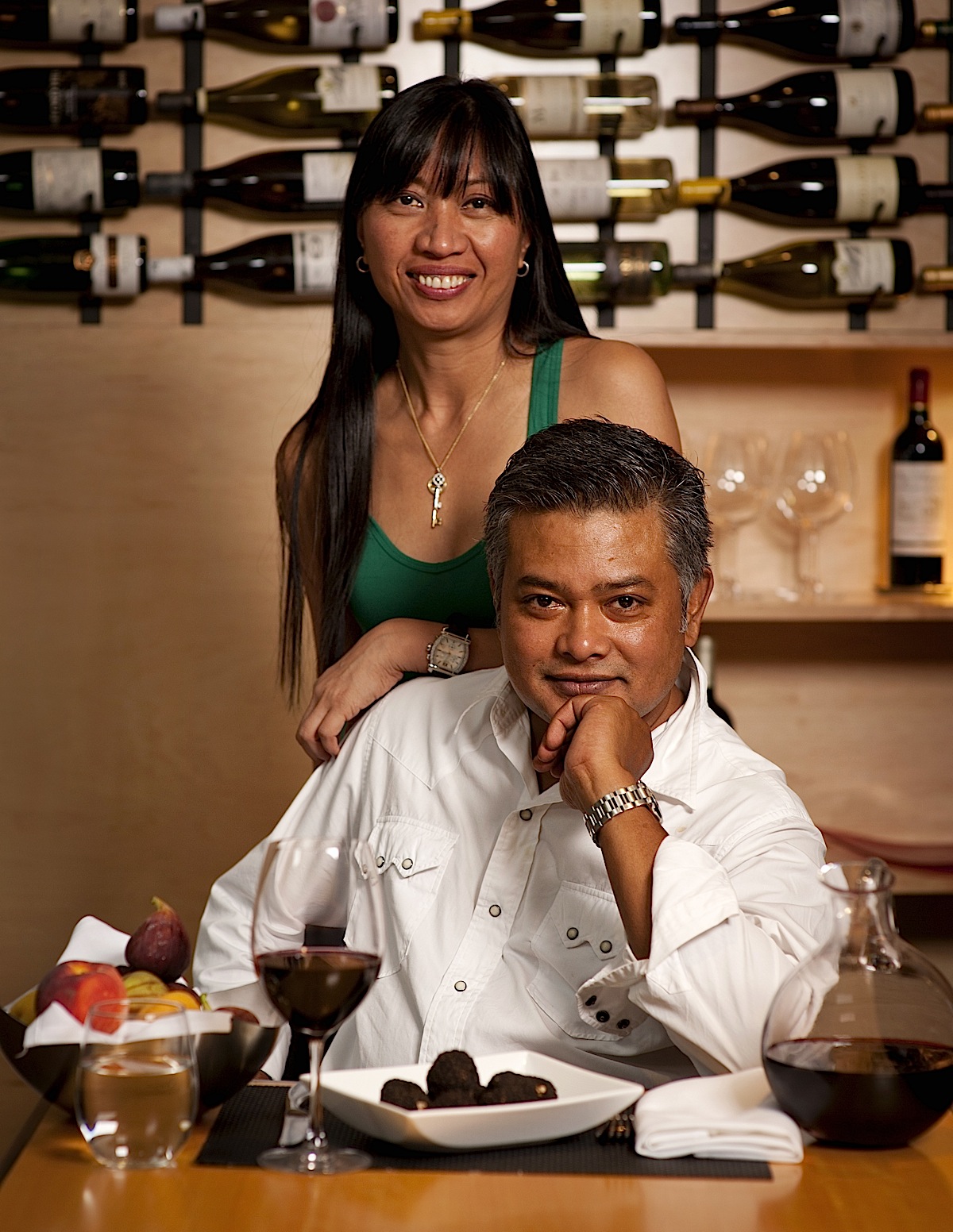 Chironis and Rahman (left), whom I
knew when they were at Le Bernardin, have
fashioned a charming series of rooms, carved from a
former garage, with the downstairs (above) the
principal dining venue, done with vivid red and white
stripes, very comfortable banquettes, and pop art-like
brown patterned carpets. The place is beautifully
lighted and buoyant, with no discernible house music
to disturb conversation. Prices are on a par
with many fine West Side restaurants but considerably
below so many French restaurants where you begin at
$100 per person. La Silhouette has a $48 pre-theater
menu ($65 with wine) and a $19 brunch. Otherwise
appetizers run $12-$28 (that last for fresh foie gras)
and main courses $29-$39--significantly below what
you'd pay for an unadorned steak at nearby beef
emporiums.
Chironis and Rahman (left), whom I
knew when they were at Le Bernardin, have
fashioned a charming series of rooms, carved from a
former garage, with the downstairs (above) the
principal dining venue, done with vivid red and white
stripes, very comfortable banquettes, and pop art-like
brown patterned carpets. The place is beautifully
lighted and buoyant, with no discernible house music
to disturb conversation. Prices are on a par
with many fine West Side restaurants but considerably
below so many French restaurants where you begin at
$100 per person. La Silhouette has a $48 pre-theater
menu ($65 with wine) and a $19 brunch. Otherwise
appetizers run $12-$28 (that last for fresh foie gras)
and main courses $29-$39--significantly below what
you'd pay for an unadorned steak at nearby beef
emporiums. They take cocktails very seriously, and the wine list, culled by Mr. Rahman--who will insist you call him Tito--is a very good balance of unusual selections and familiar bottlings in every price range. Most of the whites are under $50, and plenty of good reds under $60.
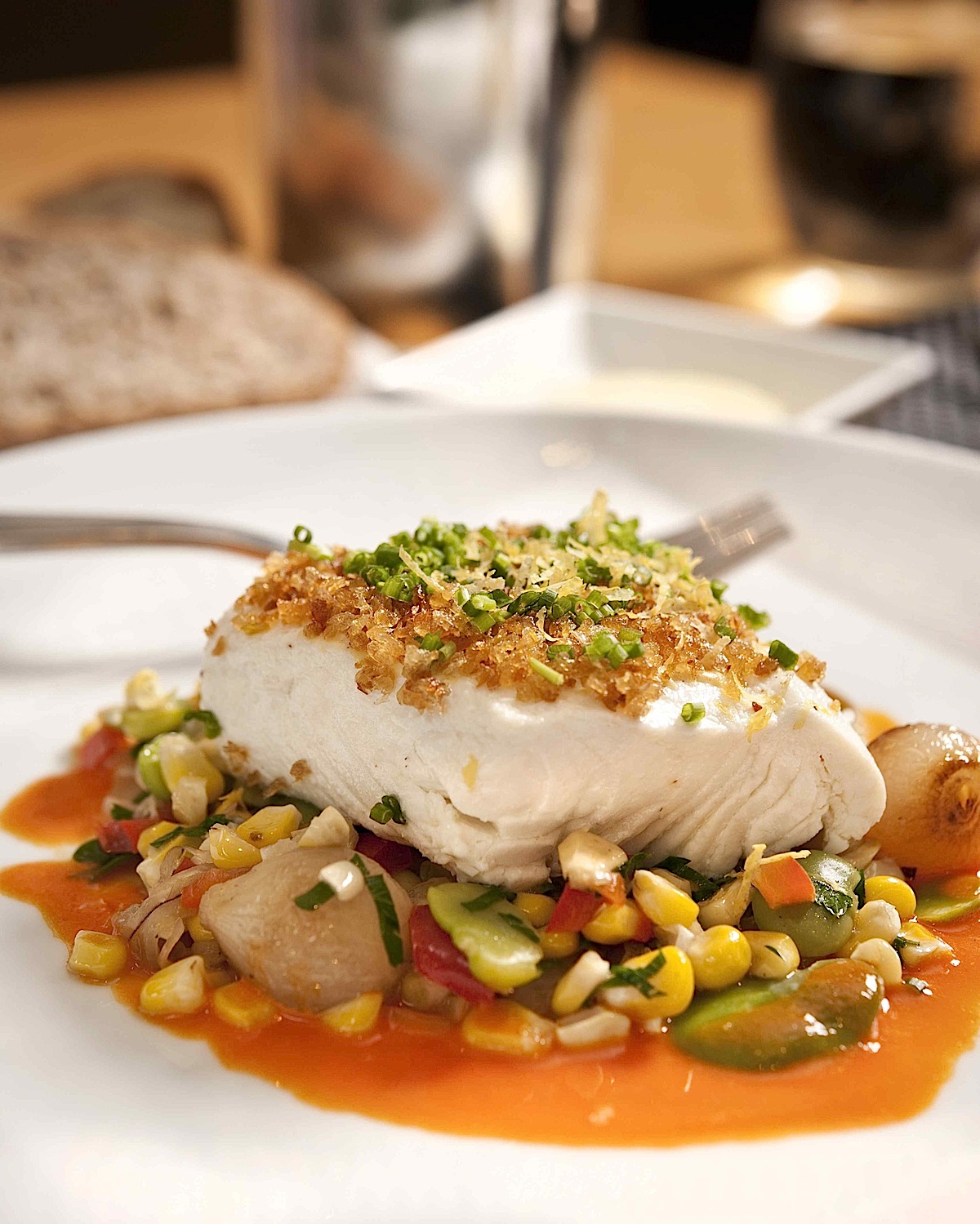
There are predictable menus, outlandish menus, and then wholly sensible menus of a kind where you really do want to try everything on them. La Silhouette's is of this last kind, nicely balanced so that the kitchen can deliver on every dish every time, and Tropeano (left) weaves his ideas into dishes that read as irresistible. One of the specialties here sounds simple but it is a small masterpiece of flavors and textures--poached farm egg (where else would eggs come from?) with asparagus, oyster mushrooms and a truffle vinaigrette. Foie gras is seared on the griddle quickly to keep its interior soft but not runny, served with caramelized peaches that are the best of the season, and the crunch of toasted almonds.
A hefty lamb chop comes with gnocchi Provençal and ragù, while snowy white halibut (right) is poached gently in olive oil, with a crispy shallot crust, succotash and piquillo peppers. Lentils du puy accompany sweet sea scallops with a julienne of vegetables and lovely saffron-mussel broth. Spiced cherries are happily added to a dish of pink duck breast with Swiss chard and quinoa.
For dessert you might go with the artisinal cheeses, but at this time of year it's tough not to order a warm apricot tart with crème fraîche-basil; ice cream, or a flourless chocolate cake with strawberry sorbet and berries.
Little on Tropeano's menu would scare off even the most conservative interloper from La Grenouille, but for everyone who visits everything here is fresh, bright, vivid and delicious. And both Tito and Sally Chironis could not be happier than to have you as guest.
La
Silhouette is open nightly, with brunch on Sat. &
Sun.

by Christopher Mariani
Komali
4152 Cole Avenue, Dallas
214-252-0200
www.KomaliRestaurant.com
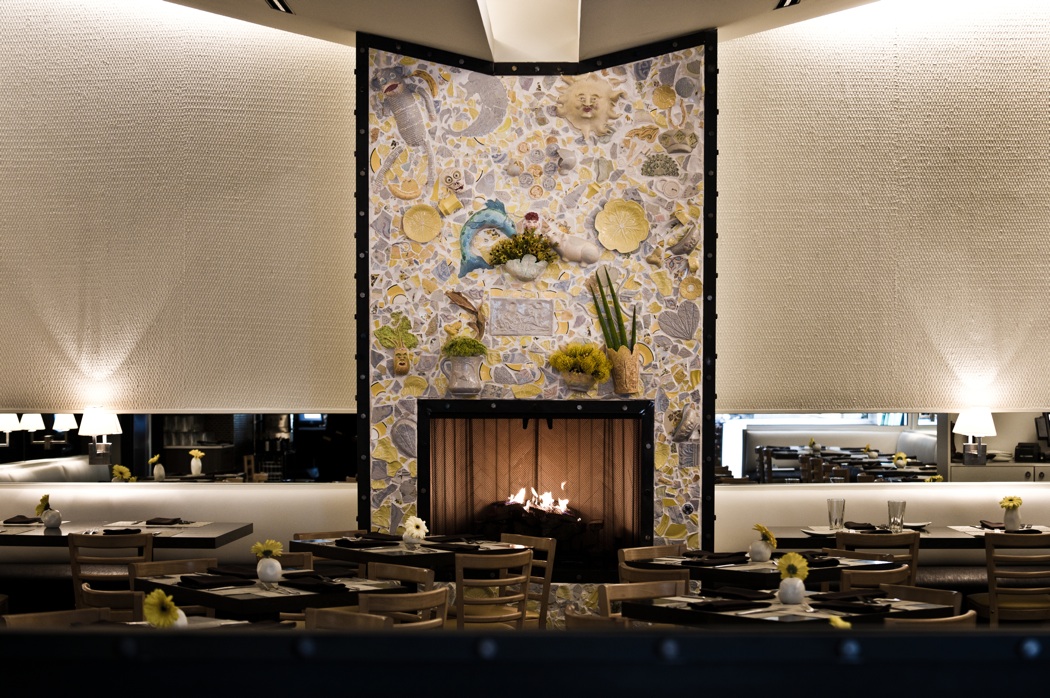 During
a recent trip to Texas I had the opportunity to stop
by and dine at chef Abraham Salum’s Komali restaurant
in Uptown Dallas. I was a bit blasé about it
when I heard Komali was a Mexican restaurant because
although the city is known for its excellent Mexican
cuisine, it is also known for plenty of dull Tex-Mex
eateries. However, Salum stated, when opening
Komali, “I want the antithesis of Tex-Mex. Look for
regional cuisine from Oaxaca, Guerrero, and Veracruz.”
I wasn’t too worried.
During
a recent trip to Texas I had the opportunity to stop
by and dine at chef Abraham Salum’s Komali restaurant
in Uptown Dallas. I was a bit blasé about it
when I heard Komali was a Mexican restaurant because
although the city is known for its excellent Mexican
cuisine, it is also known for plenty of dull Tex-Mex
eateries. However, Salum stated, when opening
Komali, “I want the antithesis of Tex-Mex. Look for
regional cuisine from Oaxaca, Guerrero, and Veracruz.”
I wasn’t too worried.
Komali (the name refers to the comal, an open
fire grill used by the Aztecs) just opened this summer
and is a wonderful addition to the Dallas culinary
scene. The space is lovely, coated in a light beige
canvas with a grand fireplace decorated with broken
tiles and iconic Mexican sculptures and murals.
There’s also a long, sleek bar graced by many of
Dallas’ well-dressed socialites. Salum, a very
humble and enthusiastic chef, cooks nightly and
occasionally pops his head out of the kitchen to tour
the dining room and say hello to guests, some of whom
sit at the communal table near the bar.
Upon sitting down, our gracious waiter
approached the table and asked, “Would anyone like a
margarita?” I, of course, nodded, yes. There is a vast
selection of terrific añejo tequilas on the
menu and an assortment of flavored margaritas. Keeping
it traditional, I ordered a standard margarita but was
encouraged to have the rim of the glass coated with a
chile powder that packed a whole lotta’ spice into
each mouthful, a very nice touch. After a margarita or
two, I saw the restaurant begin to fill up, leaving
not one seat empty in the whole place. Komali, like
any new restaurant in the city, is packed nightly and
getting lots of hype from local diners, and rightfully
so.
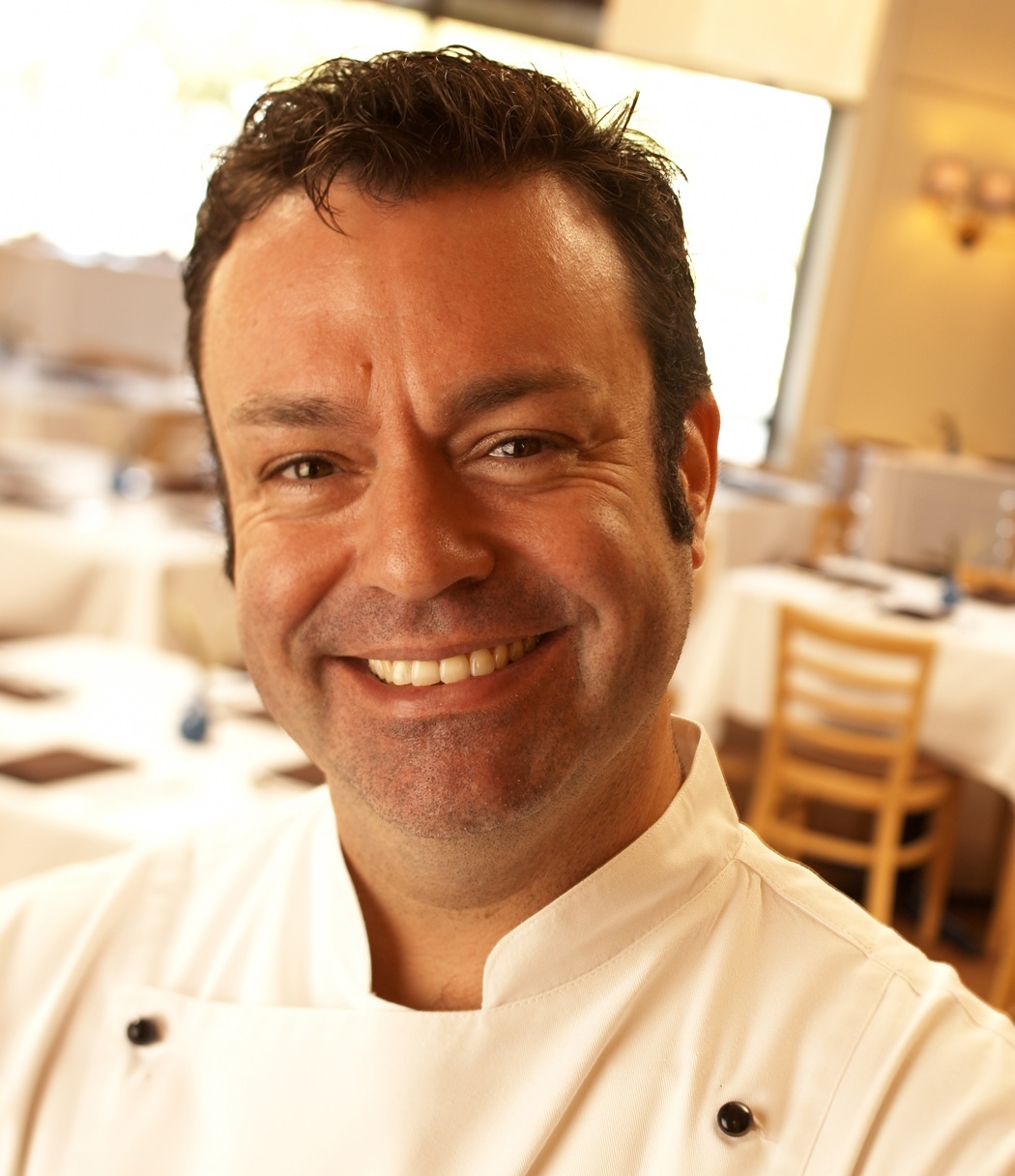 Salum (left) is
preparing some of the city’s finest authentic Mexican
cuisine in a refined manner, serving dishes packed
with tons of flavor and lots of heat. We started with
some appetizers you should not miss, Oaxaca-style
tamales topped with a thick brown mole sauce, chorizo sopes and tender
pork tostadas. There
is a wonderful rich black bean soup, a runner-up to
Dean Fearing’s version just across town, but still a
contender, while the crema de pobano with queso fresco
was uniquely its own. Ceviche comes splashed with
fresh lime juice, mixed with fresh avocados, cilantro
and red onions. There is also a choice of quesadillas
del dia--a
daily mix of three quesadillas with roasted tomato.
Salum (left) is
preparing some of the city’s finest authentic Mexican
cuisine in a refined manner, serving dishes packed
with tons of flavor and lots of heat. We started with
some appetizers you should not miss, Oaxaca-style
tamales topped with a thick brown mole sauce, chorizo sopes and tender
pork tostadas. There
is a wonderful rich black bean soup, a runner-up to
Dean Fearing’s version just across town, but still a
contender, while the crema de pobano with queso fresco
was uniquely its own. Ceviche comes splashed with
fresh lime juice, mixed with fresh avocados, cilantro
and red onions. There is also a choice of quesadillas
del dia--a
daily mix of three quesadillas with roasted tomato.
Entrees include a thick cut of salmon wrapped
in banana leaf and rubbed with achiote and bitter orange abobo. There’s a nice beef tenderloin
topped with fried goat's cheese and a side of almendrado sauce. The
meat options
are lengthy and go on to offer Mexican meatballs,
grilled pork chops drizzled with honey and a braised
pork soup with cabbage and onions.
For dessert, I recommend the goat's milk
crêpes served with caramelized plantains and
toasted pecans along with the sugar dusted churros served
with a cup of Abuelita hot chocolate.
Salum cooks what he preaches and is showcasing
food as far from Tex-Mex as possible. His dishes have
gusto and he is not afraid to serve exactly what he
desires. Salum is one of the few chefs who is taking
Mexican fare to new levels by evolving many of the old
dishes yet never losing the traditional flavor found
throughout Mexico.
To contact Christopher Mariani send an email to
christopher@johnmariani.com
Follow @VirtualGourmet
❖❖❖
Merlot Shines under Northstar
By Brian A. Freedman
For consumers who still
inexplicably adhere to the "Sideways" school of
thought--Merlot is universally bad, Pinot is
universally good, and the wine world is easily divvied
up into clean-lined categorical imperatives--the Walla
Walla Valley and neighboring AVAs of Washington State
offer a delicious refutation. They are, I’ve grown
convinced, home to some of the best Merlots this
country produces, and with its passionate, dedicated
supply of winemakers and vineyard owners, they only
promise to get better.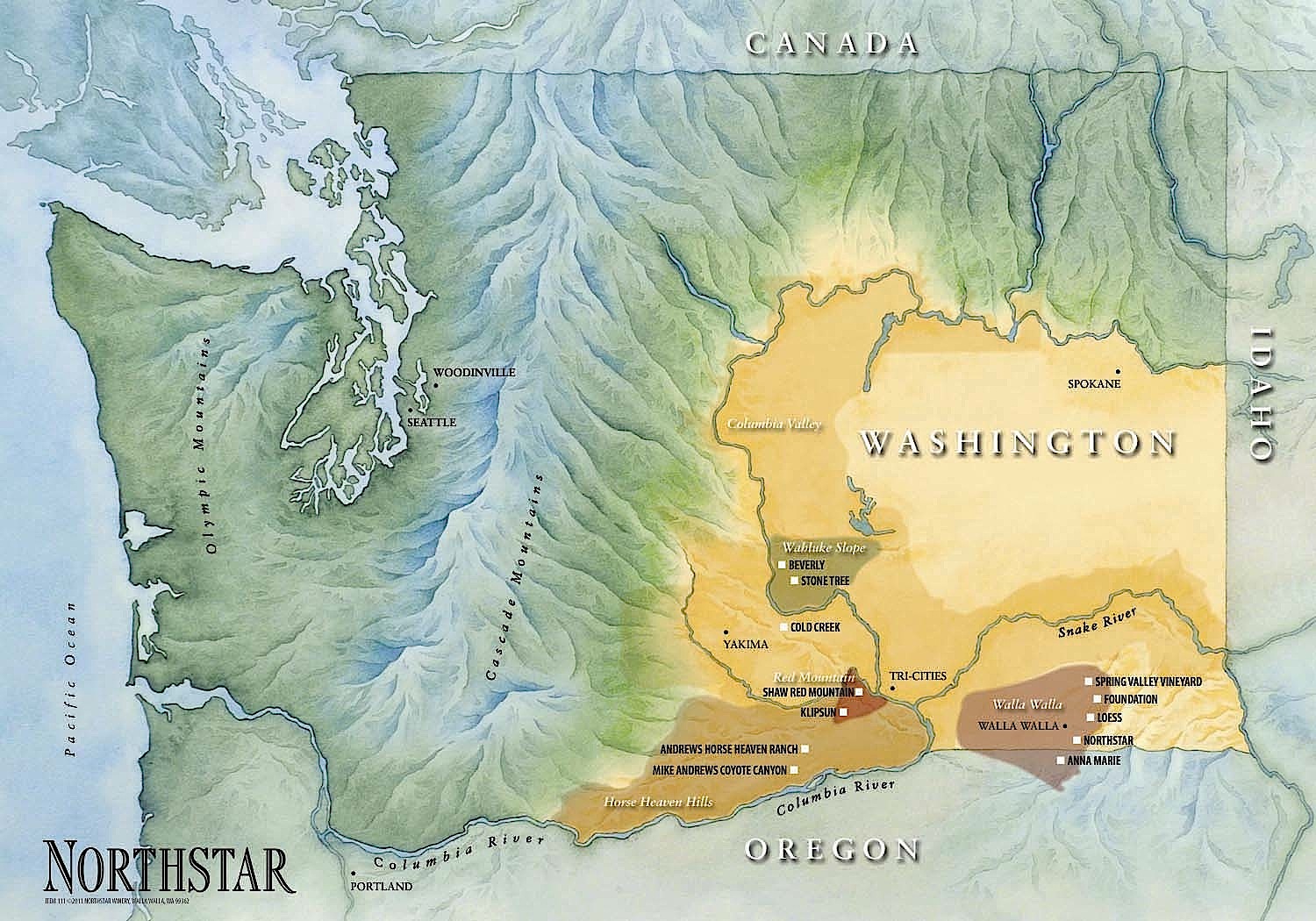
Fans of the region’s reds have known about this
secret for years. Now, however, word is leaking out,
and with a renewed focus on the Pacific Northwest in
both the wine press and at the retail level, these
AVAs--Walla Walla Valley, Columbia Valley, Red
Mountain, Horse Heaven Hills, etc.--seem to be
on the verge of a serious (and seriously well-earned)
popularity explosion.
This was brought into deliciously sharp relief
this past July when I attended Merlot Camp, a
three-day immersion into all things Merlot and
Washington, put on by the excellent producer
Northstar. Over the course of my time there--I was
joined by eight journalists and two members of the
wine trade--I had the opportunity not only to explore
the various iterations of the region’s uniquely
expressive Merlots (and other grape varieties as
well), but also to see exactly what makes this unique
place such a remarkable home for America’s most
inappropriately denigrated grape variety.
Any discussion of this part of Washington
inevitably starts 15 million years ago, and this is
exactly where my education at camp began. Dr. Kevin
Pogue of Whitman College’s Department of Geology
kick-started the immersion with a lecture and
presentation on the geological history of the area.
Over the course of this discussion, several things
became clear. First, great wine regions don’t happen
by mistake; they are the result of geological forces
and phenomena thousands of millennia in the making.
Second, the wines produced in these regions are a
result of culture, of stylistic tendencies and the
sense of community and shared knowledge that develop
in the best regions, as well as non-human forces.
As for the latter, lava flows 15 million years
ago created the basaltic bedrock that’s such an
important aspect of the terroir here. Then, 15,000 to
12,000 years ago, huge glacial floods, according to
the Walla Walla Valley AVA’s web site, “deposited much
of the well-drained sand and silt that today forms the
soil of the Walla Walla Valley American Viticultural
Area (AVA). . . . After the floods, ash derived from
the eruptions of Cascade Range volcanoes was deposited
throughout the region adding even more complexity to
the Valley’s soil.”
Practically speaking, this means that the
rooting zone for the vast majority of vineyards here
is typically wind-blown silt, which has a significant
impact on the ways in water moves through the
vineyard. Beyond that, however, the diversity of soil
types and overall surface geology has the effect of
accommodating any number of styles of resulting wine.
This was brought home during a blending exercise we
participated in that included samples from a number of
the ones we visited, including standouts like Klipsun
Vineyard in the Red Mountain AVA and 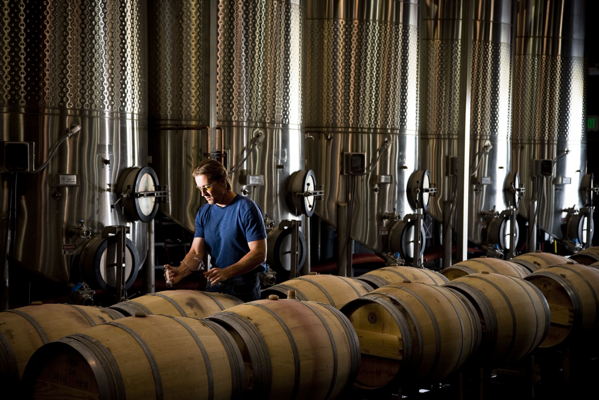 Anna Marie
Vineyard in the Walla Walla AVA: Each one provides
something unique to the final blend of a wine,
and in a carefully considered final cuvee, the
idiosyncrasies of each--spiciness, lush fruit,
chocolate notes, tannic backbone, etc.--add up to
that unique character that so beguiles fans of the
Merlots here.
Anna Marie
Vineyard in the Walla Walla AVA: Each one provides
something unique to the final blend of a wine,
and in a carefully considered final cuvee, the
idiosyncrasies of each--spiciness, lush fruit,
chocolate notes, tannic backbone, etc.--add up to
that unique character that so beguiles fans of the
Merlots here.
As a
result of over-cropping and under-thinking in certain
parts of the American wine firmament, many consumers
wrote off Merlot long ago. But as believers in the
grape variety know, it is more than capable of
producing wines of utterly astounding depth and
complexity in both single-varietal bottlings and
blends. (How many people, really, would turn their
nose up at a bottle of Pétrus?)
Luckily,
Merlot is staging a bit of a comeback among wine
lovers, and it’s likely only a matter of time until it
breaks through the wider popular wine-snob aversion to
it. And if I had to guess, I’d predict that the
standout AVAs of Washington will continue to be
leaders in the renaissance of American Merlot.
Much of this comes down, quite simply, to
style. As a result of the unique geology and terroir
here, the Merlot is actually more tannic
than the Cabernet Sauvignon. Right off the bat, this
confounds the easy stereotype that Merlot is an
inherently soft-souled--not to say flabby--grape
variety. But that doesn’t mean that it’s rough here;
far from it. Rather, the Merlot in this part of the
country, to speak in gross generalities, exhibits
plenty of fruity depth but also an excellent sense of
structure alongside the sort of tobacco, spice, and
mineral notes that connoisseurs of great Merlot-based
wine swoon over.
They age well, too. In what was one of the best
opening-night tastings of a wine-immersion experience
I’ve had in a long time, Northstar winemaker David
“Merf” Merfeld (above)
and his wife, Lynne Anderson, hosted our group at
their home for a fantastic dinner prepared by local
star chef and accomplished organic farmer Greg
Schnorr. Over the course of the evening, we tasted a
vertical of Northstar’s Columbia Valley Merlots from
2007-1998, as well as a magnum of 1994. These bottles
demonstrated just how elegantly the wines here can
age, and how nuanced they become without losing the
sense of exuberance that characterized them in their
youth. (Its tasting room is shown in the photo
below.)
The primary red fruit of the 2007 still
dominated, though the entirety of the wine still
remained balanced. The 2006, on the other hand, was
already far more complex, with smoke and warm clay
aromas, a lush mouthfeel, and flavors of dulce de
leche, cinnamon, and cherry. The 2005 showed more
chocolate and kirsch, as well as a hint of birch bark,
and the 2004 boasted a seam of eucalyptus and bright
red fruit, both the result of a freeze and cooler
weather that hit the region that year. 2003 found its
footing on the opposite side of that coin with sappy
cherry compote flavors--a sharp contrast to the
spicier raspberries and drivingly youthful tannins of
the 2002: This is one for the cellar. 2001 practically
hovered above the glass with its licorice perfume and
exuberantly expressive cherry fruit, and the 2000, all
warm-souled cedar, lush fruit, and a touch of
marzipan, remained remarkably persistent at 11 years
old. The 1999 nodded in the direction 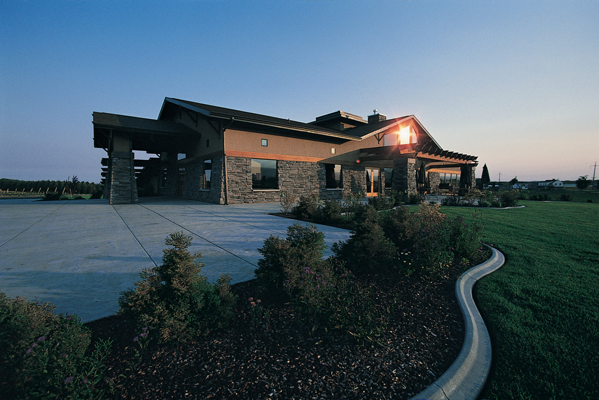 of Right Bank
Bordeaux with its dark cherries, fine-grained tannins,
sage, green cigar tobacco, and spicy cedar. Amazingly,
even at 13 years of age, the 1998 showed popping-fresh
raspberries and other red berry fruit, in addition to
beguiling secondary notes of leather and tobacco. And,
finally that night, there was the magnum of 1994, a
classic mature Merlot with perfect acidity and
minerality for freshness, as well as deeply complex
toasted vanilla, creamy tobacco, spice, and leather.
of Right Bank
Bordeaux with its dark cherries, fine-grained tannins,
sage, green cigar tobacco, and spicy cedar. Amazingly,
even at 13 years of age, the 1998 showed popping-fresh
raspberries and other red berry fruit, in addition to
beguiling secondary notes of leather and tobacco. And,
finally that night, there was the magnum of 1994, a
classic mature Merlot with perfect acidity and
minerality for freshness, as well as deeply complex
toasted vanilla, creamy tobacco, spice, and leather.
Northstar is also working
on a proprietary bottling called, right now at least,
the “Big Dipper.” 2009 will be the first vintage, and
its goal is to express, in premium-cuvée form,
the full potential of Merlot here to be both enjoyable
young as well as to age. I tasted a barrel sample, and
the early results are astounding: high-toned red fruit
on the nose, as well as perfumed spice that will continue to be absorbed from the
barrels, and a
palate of sweet, balanced black fruit, grilled herbs,
tobacco, scorched earth, and a hint of tar. It
promises to be a two-decade wine that will be
approachable long before then. Even a month after
tasting it, I can still conjure up its character.
And that, it seems, is the hallmark of a great
wine and a great wine-producing part of the world. The
wines of this part of Washington, and the Merlots in
particular, are exactly what both the grape variety
itself and the American wine-consuming public need.
It’s rare to find such approachability, complexity,
agability, and exuberance from a single corner of the
wine firmament. Combine that with the all-for-one-goal
attitude that seems to permeate the region, and you
have all the ingredients for continued success. And,
I’d guess, a renaissance of American Merlot--starting
right here, in Walla Walla, Columbia Valley, and their
neighboring AVAs in Washington State.
Follow @VirtualGourmet
❖❖❖
 TRAVEL ARTICLES WE
TRAVEL ARTICLES WE
NEVER
FINISHED
READING
“`BWOK!”
“BWOK!”
“BWOK-BWOK-BWOK!'
The
back
seat
of
the
car
erupts in a riot of barnyard noises with every
scraggly gaggle of chickens we pass. The boys,
innocents of 5 and 3, are so excited to see actual
real live chickens here on the quiet side of Grand Cayman
you’d think they were watching leopards attack baboons
in Zambia. It’s a symptom of the suburban captivity in
which they are being raised and, therefore, nobody’s
fault but my own, but the incessant bwok-bwok-bwoking
is driving me nuts."--Dave Herndon, "Creature
Comforts: The Ultimate Cayman Island Family Vacation," Caribbean
Travel and Life .
DON'T CLUB OWNERS AND COPS KNOW A 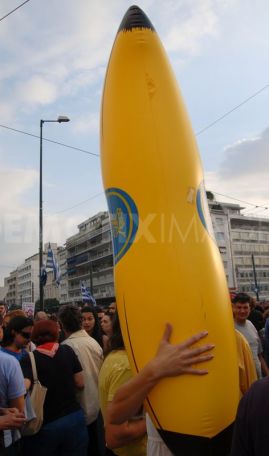
PRADA
HANDBAG WHEN THEY SEE ONE???
On Miami
Beach, Club Cameo refused entrance to Beyoncé
Knowles' sister Solange because she was carrying an
inflatable banana. Knowles, however, contended she was
denied for racial reasons, then allegedly became
"unruly" with off-duty officers, who "took her across
the street to try and calm her down," at which point,
says Knowles, they pulled a switchblade on her
banana. According to the Miami Herald, "Police
said they did not take the banana into custody, and it
is still unclear why Knowles was club-hopping with the
fake fruit."
❖❖❖
Any of John Mariani's
books below may be ordered from amazon.com.
"Eating Italian will never be the same after reading John Mariani's entertaining and savory gastronomical history of the cuisine of Italy and how it won over appetites worldwide. . . . This book is such a tasteful narrative that it will literally make you hungry for Italian food and arouse your appetite for gastronomical history."--Don Oldenburg, USA Today. "Italian
restaurants--some good, some glitzy--far
outnumber their French rivals. Many of
these establishments are zestfully described
in How Italian Food Conquered the World, an
entertaining and fact-filled chronicle by
food-and-wine correspondent John F.
Mariani."--Aram Bakshian Jr., Wall Street
Journal.
"Equal parts
history, sociology, gastronomy, and just
plain fun, How Italian Food Conquered the
World tells the captivating and delicious
story of the (let's face it) everybody's
favorite cuisine with clarity, verve and
more than one surprise."--Colman Andrews,
editorial director of The Daily
Meal.com. "A fantastic and fascinating
read, covering everything from the influence
of Venice's spice trade to the impact of
Italian immigrants in America and the
evolution of alta cucina. This book will
serve as a terrific resource to anyone
interested in the real story of Italian
food."--Mary Ann Esposito, host of PBS-TV's
Ciao
Italia. "John Mariani has written the
definitive history of how Italians won their
way into our hearts, minds, and
stomachs. It's a story of pleasure over
pomp and taste over technique."--Danny Meyer,
owner of NYC restaurants Union Square Cafe,
Gotham Bar & Grill, The Modern, and
Maialino.
|
 |
 |
 |
 |
 |
 |
 |
 |
 Everett Potter's Travel Report:
Everett Potter's Travel Report: 
 Eating Las Vegas
is the new on-line site for Virtual Gourmet
contributor John A. Curtas., who since 1995
has been commenting on the Las Vegas food
scene and reviewing restaurants for Nevada
Public Radio. He is also the
restaurant critic for KLAS TV, Channel 8 in
Las Vegas, and his past reviews can be
accessed at KNPR.org.
Click on the logo below to go directly to
his site.
Eating Las Vegas
is the new on-line site for Virtual Gourmet
contributor John A. Curtas., who since 1995
has been commenting on the Las Vegas food
scene and reviewing restaurants for Nevada
Public Radio. He is also the
restaurant critic for KLAS TV, Channel 8 in
Las Vegas, and his past reviews can be
accessed at KNPR.org.
Click on the logo below to go directly to
his site.

Tennis Resorts Online: A Critical Guide to the World's Best Tennis Resorts and Tennis Camps, published by ROGER COX, who has spent more than two decades writing about tennis travel, including a 17-year stretch for Tennis magazine. He has also written for Arthur Frommer's Budget Travel, New York Magazine, Travel & Leisure, Esquire, Money, USTA Magazine, Men's Journal, and The Robb Report. He has authored two books-The World's Best Tennis Vacations (Stephen Greene Press/Viking Penguin, 1990) and The Best Places to Stay in the Rockies (Houghton Mifflin, 1992 & 1994), and the Melbourne (Australia) chapter to the Wall Street Journal Business Guide to Cities of the Pacific Rim (Fodor's Travel Guides, 1991).


The Family Travel Forum - A
community for those who "Have Kids, Still Travel" and
want to make family vacations more fun, less work and
better value. FTF's travel and parenting features,
including reviews of tropical and ski resorts, reunion
destinations, attractions, holiday weekends, family
festivals, cruises, and all kinds of vacation ideas
should be the first port of call for family vacation
planners. http://www.familytravelforum.com/index.html
ALL YOU NEED BEFORE YOU GO


MARIANI'S VIRTUAL GOURMET
NEWSLETTER is published weekly. Editor/Publisher: John
Mariani.
Contributing Writers: Christopher Mariani, Robert Mariani,
John A. Curtas, Edward Brivio, Mort Hochstein,
Suzanne Wright, and Brian Freedman. Contributing
Photographers: Galina Stepanoff-Dargery,
Bobby Pirillo. Technical Advisor: Gerry McLoughlin.
© copyright John Mariani 2011
